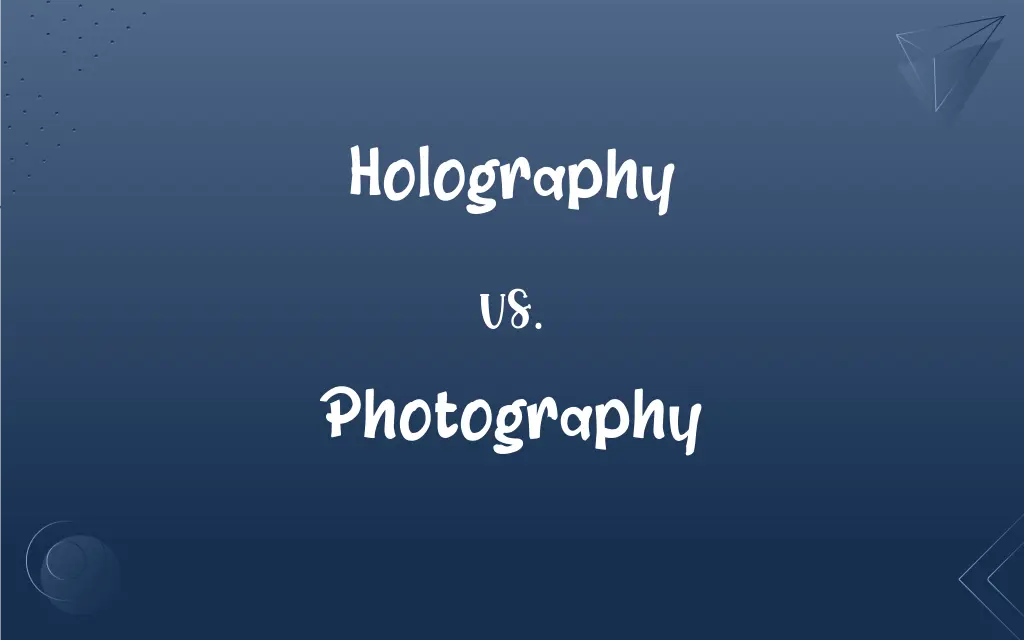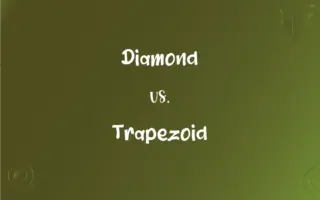Holography vs. Photography: What's the Difference?
Edited by Aimie Carlson || By Harlon Moss || Published on February 24, 2024
Holography creates three-dimensional images using light patterns, whereas photography captures two-dimensional images through a lens on light-sensitive surfaces.

Key Differences
Holography captures and reproduces the three-dimensional structure of a scene using the interference pattern of light. Photography, in contrast, records a two-dimensional representation of a scene, capturing only the light intensity and color.
Holography involves recording light fields rather than light intensity, using laser beams to create holograms. Photography relies on lenses to focus light onto a photosensitive surface, like film or a digital sensor, to create an image.
Viewing a hologram provides a multi-dimensional perspective, changing with the viewer's position. A photograph offers a fixed perspective, maintaining the same view regardless of the viewer's angle.
Holography requires lasers, beam splitters, mirrors, and holographic film. Traditional photography uses cameras with lenses and either film or digital sensors.
Holography has specialized applications like data storage, security, and art. Photography has broader applications, capturing everything from everyday moments to professional art and journalism.
ADVERTISEMENT
Comparison Chart
Dimensionality
Three-dimensional
Two-dimensional
Image Formation
Light interference and diffraction
Light intensity capture on a photosensitive surface
Viewing Experience
Changes with viewer’s position
Remains the same regardless of viewpoint
Equipment
Lasers, beam splitters, holographic film
Cameras, lenses, film or digital sensors
Applications
Art, security, data storage
Wide-ranging from personal use to professional art
ADVERTISEMENT
Image Characteristics
Can display depth and parallax
Flat representation with no depth perception
Technique
Recording of light fields
Recording of light through a lens
Image Stability
Sensitive to light and angle changes
Stable under various lighting and angles
Reproduction
Requires specific setup for viewing
Can be viewed easily in various formats
Cost and Accessibility
Generally more complex and costly
Widely accessible and varies in cost
Holography and Photography Definitions
Holography
Holography often uses laser light to record detailed holograms.
For the holography project, they used a laser to ensure precision.
Photography
Photography captures a moment in time in a two-dimensional format.
The photography contest celebrated the best captures of urban life.
Holography
Holography is a technique for creating three-dimensional images using light interference.
The museum displayed a holography exhibit with lifelike 3D images.
Photography
Photography is the art or process of creating images by capturing light on a sensitive surface.
Her photography skills captured the stunning landscape perfectly.
Holography
It records and reconstructs the light field emitted by an object.
Holography captured the entire light field of the sculpture for a realistic display.
Photography
It involves using a camera to record visual images.
He pursued photography as a hobby, taking pictures with his digital camera.
Holography
Holographic images change appearance based on viewing angle.
The holography artwork showed different colors from various angles.
Photography
Photography can be either digital or analog, using sensors or film.
Her photography exhibition included both digital images and traditional film prints.
Holography
Holography can store and retrieve information in three dimensions.
They used holography for advanced data storage solutions.
Photography
It encompasses various genres, including portrait, landscape, and documentary photography.
His photography focused on wildlife, showcasing animals in their natural habitats.
Holography
A method of producing a three-dimensional image of an object on a photographic plate or film by recording on it the interference pattern formed by a split laser beam, one beam of which illuminates the object while the other does not. Illuminating the pattern either with a laser or with ordinary light produces the image.
Photography
The art or process of producing images of objects on photosensitive surfaces.
Holography
(physics) a technique for recording, and then reconstructing, the amplitude and phase distributions of a coherent wave disturbance; used to produce three-dimensional images or holograms
Photography
The art, practice, or occupation of taking and printing photographs.
Holography
The process of producing holograms, usually requiring a source of coherent light, as from a laser.
Photography
A body of photographs.
Holography
The branch of optics that deals with the use of coherent light from a laser in order to make a hologram that can then be used to create a three-dimensional image
Photography
The art and technology of producing images on photosensitive surfaces, and its digital counterpart.
Go on a photography course
Photography
The occupation of taking (and often printing) photographs.
Photography
The science which relates to the action of light on sensitive bodies in the production of pictures, the fixation of images, and the like.
Photography
The art or process of producing pictures by this action of light.
Photography
The act of taking and printing photographs
Photography
The process of producing images of objects on photosensitive surfaces
Photography
The occupation of taking and printing photographs or making movies
FAQs
How does holography differ from photography in terms of dimensionality?
Holography captures three-dimensional images, while photography captures two-dimensional images.
What is photography?
Photography is the process of creating two-dimensional images by capturing light on a photosensitive surface.
Can photographic images be easily reproduced?
Photographic images can be easily reproduced and viewed in various formats.
What is holography?
Holography is a method of creating three-dimensional images using light patterns and interference.
What equipment is essential for holography?
Holography typically requires lasers, beam splitters, and holographic film.
What are common uses of holography?
Holography is commonly used in art, security, and data storage.
Is holography more costly than photography?
Generally, holography is more complex and costly compared to photography.
What are the basic tools for photography?
Basic tools for photography include a camera and either film or a digital sensor.
Is photography capable of capturing depth?
Photography captures the illusion of depth but is inherently a two-dimensional medium.
How does the viewer's angle affect holographic and photographic images?
The viewer's angle affects the appearance of holographic images but not photographic images.
How is photography typically used?
Photography is used in a wide range of applications, from personal memories to professional art and journalism.
Does holography require specific viewing conditions?
Yes, viewing holographic images often requires specific lighting and angle conditions.
Can photography be both digital and analog?
Yes, photography can be both digital (sensors) and analog (film).
Can holography show depth and parallax?
Yes, holography can show depth and parallax, changing with the viewer's position.
What type of light is used in holography?
Holography often uses laser light for its coherence and precision.
What are the key skills for holography and photography?
Holography requires understanding light interference and precision, while photography focuses on composition, lighting, and camera operation.
Do holographic images require special equipment to view?
Some holographic images require special lighting or angle conditions to be viewed properly.
Can holography and photography be combined?
Holography and photography can be combined in creative ways, though they are distinct techniques.
What is the historical significance of holography and photography?
Both holography and photography have revolutionized how we capture and view images, with photography dating back to the 19th century and holography emerging in the mid-20th century.
How accessible is photography to the general public?
Photography is widely accessible, with a range of equipment suitable for amateurs to professionals.
About Author
Written by
Harlon MossHarlon is a seasoned quality moderator and accomplished content writer for Difference Wiki. An alumnus of the prestigious University of California, he earned his degree in Computer Science. Leveraging his academic background, Harlon brings a meticulous and informed perspective to his work, ensuring content accuracy and excellence.
Edited by
Aimie CarlsonAimie Carlson, holding a master's degree in English literature, is a fervent English language enthusiast. She lends her writing talents to Difference Wiki, a prominent website that specializes in comparisons, offering readers insightful analyses that both captivate and inform.






































































